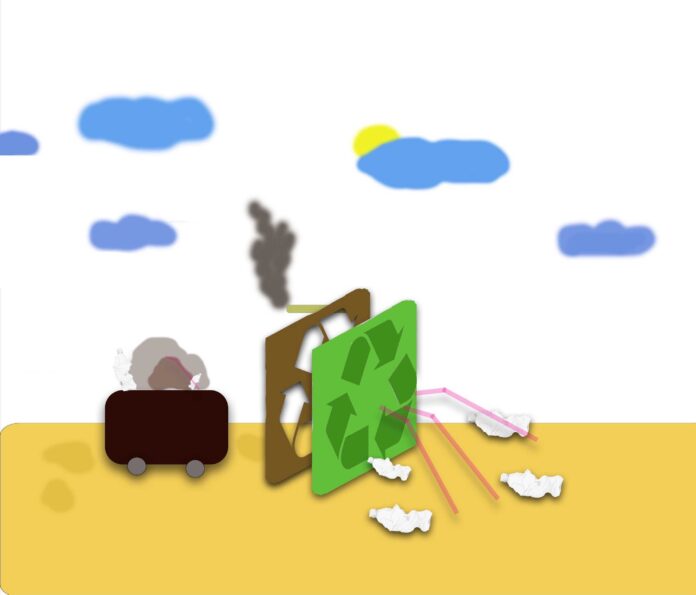According to the World Economic Forum, only about 14 per cent of plastic packaging is collected for recycling purposes. Within that number, a majority will ultimately end up burned or tossed into landfills as it will not pass through the requirements for recycling.
Evidently, this is a system which needs re-thinking, and it is clear that recycling alone will not cut it when considering greater environmental issues like plastic pollution and climate change. Enter a possible solution — reusable alternatives.
Canada currently uses 4.6 million tonnes of plastic every year. Canadians also use 1.4 per cent of all plastic produced, even though they only make up 0.5 per cent of the global population. The immediate thought may be to pursue better recycling programs, however recycling programs are not necessarily what they seem. When a product is put into a recycling bin, there is no guarantee that it will actually be recycled.
In March 2021, Imprint published an article diving into the question of if plastic straw alternatives were that much better than plastic straws themselves. The article determined that it depended on your lifestyle. If you used straws often and remembered to take an alternative with you, then that was a good option. If not, it may be better to go without.
According to thesis research conducted by Takunda Chitaka, a postdoctoral research fellow at the University of the Western Cape in South Africa, for a single reusable steel straw to have less of an impact than the original product or material, it needs to be used 37 times, which often is not achievable, as reusable alternatives are lost or forgotten.
Chitaka said consumers should instead be encouraging governments and businesses to invest in alternatives and systematic changes to redesign plastics and improve recycling infrastructure across all plastics. So what about those other alternatives to plastic items like water bottles, containers and packaging? Are the alternatives worth it and are recycling programs really effective?
The thought behind reusable alternatives is the concept of a circular economy — a model of production and consumption that relies on the sharing, reusing, refurbishing and recycling of existing materials for as long as possible. By replacing single-use containers with those made of metal or glass that can be reused either by the company or the consumer, companies are participating in a circular economy.
According to the Ellen Macarthur Foundation, a charity committed to creating a circular economy, three actions must be taken to create a circular economy for plastics — eliminate unnecessary plastics, innovate to ensure remaining plastics are reusable, recyclable or compostable, and circulate those plastic items to keep them in the economy and out of the environment.
Some companies are getting on board with the idea. Lush, a cosmetics company from the UK, encourages reusing and recycling their hard plastic containers, through labels on their products. The company also incentivizes this circular model through its own collection program, allowing customers bring back five containers in exchange for a free face mask, with the end goal of reusing these containers.
Loop is another company dedicated to practicing the circular economy model. The company is a startup associated with Terra Cycle which launched in Canada in 2021 as an e-commerce platform selling food, toiletries and household essentials in reusable packaging. Consumers purchase a product in a reusable glass or metal container and then send back the empty packaging for cleaning and refilling. Though there are shortcomings — ordering from the site is expensive since customers must pay for shipping and it is somewhat inconvenient when handling larger orders.
If Chitaka’s research methodology is applied here, how “worth it” changing plastic products are can be approximated. Using a simple formula provided by David Evans, a writer on plastic pollution, the environmental impacts of reusable and non-reusable products can be determined: total environmental impact = cost of production + cost of use + cost of post use, or disposal.
Evans uses a cup as an example. The energy to produce a reusable cup is higher than that of a non-reusable cup, as non-reusables are lighter, smaller and easier to make, while reusables require more resources and energy. The cost of use then depends on how many times a reusable product is handled. In this case a reusable cup made of glass will have a positive environmental impact in six uses when compared to a non-reusable, plastic cup in seven uses. Reusable cups then have a longer lifespan and most can be recycled at the end of their life. Overall, production costs for reusables are higher than non-reusables, but their utility and disposal costs are both lower. They require less oil to produce and diminish the plastic burden on landfills, oceans and other ecosystems.
So is it worth it? Ultimately, we will not be able to recycle our way out of climate change, said senior reporter Gosia Wozniacka of Civil Eats in an article on the site, but we can switch to alternatives and encourage governments and businesses to redesign plastics and improve recycling infrastructure. It again comes down to how many times a reusable product is reused. Companies like Lush and Loop can be seen as a stepping stone — a service on the way to developing a better recycling infrastructure that makes a space for reusable products to be utilized by consumers.






























